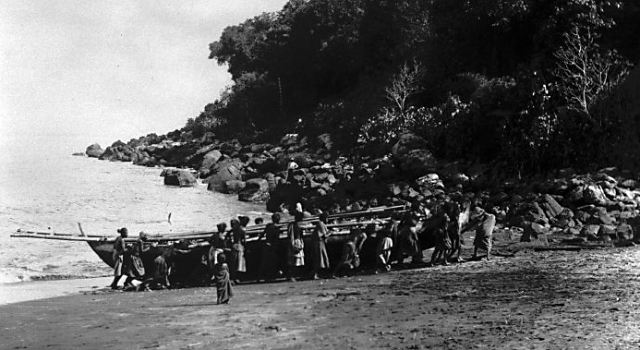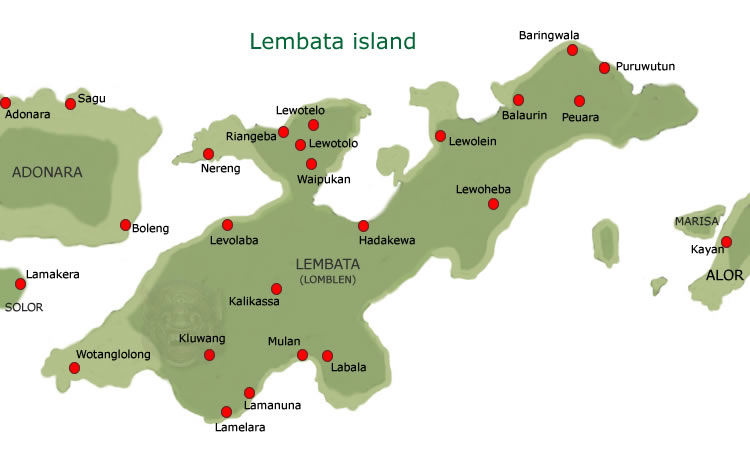Lembata - the whalers' islandLembata, formerly called Lomblem, is the largest of the islands in the Solor Archipelago. It has three active volcanoes and a dormant one, Ili Api, which dominates the scenery in the north. Much of the island is wooded, other parts have fertile soil suitable for agriculture. Christian missionaries have been very active on the island since the 1930's. They have done much to improve health and education, but have also eradicated many traditional practices. Fortunately, weaving was not under attack, probably because it was seen as useful in keeping the natives clothed, and relatively harmless in terms of idolatrous misbehaviour. An old Lembata sarong adat ranks among the most sought after Indonesian textiles. Why is this so? Lembata ikats are made of coarse hand spun cotton, the colour palette is limited to dark earthy tones, and precision is not their hallmark. So then what is the attraction? The answer is probably similar to what we wrote about Alor: the island is steeped in mystery because it played no role of significance in colonial times, there is a marked lack of sophistication (a way of saying that its art has a primitive feel without using the banned word), and it was the subject of impressive studies - in this case three. In the late 1920s came Ernst Vatter, in the 1930s Alfred Bühler, and in the 1990s Ruth Barnes. All three wrote about the island's textiles with palpable passion, if not awe. They were in awe of the weavers' strict adherence to adat, the ancient system of customs and taboos that dictated every stage of production, the vast amounts of time invested in making a proper bridewealth cloth (usually years), and the idiosyncrasy of the cloths' overall appearance. There is no mistaking a Lembata sarong for anything else. Also, Ruth Barnes wrote with barely managed fury about the disappearance, due to consecutive invasions by dealers, of textiles that were vital to the island communities' wellbeing. 
Whalers of Lamalera pulling their peledang back onto the beach after a day's work - a scene that might have been photographed today, but actually dates from around 1915. Photographer unknown, Tropenmuseum of the Royal Tropical Institute (KIT), Creative Commons Licence. Four centres of weavingIn the scarce literature, three centres of weaving are mentioned most frequently as sources of high quality ikat: Lamalera (also called Lamalerap), Atadei (also called Lerek after the region) and Ili Api. There is also a fourth region, Kedang, in the north-east, with the port village of Balauring as its main trading centre, that culturally stands apart from the rest of the Lembata. The Kedang do not speak Lamaholot but related Tutuq-Nanang Wela, 'the language of the mountain'. The ikat from Kedang is surrounded by mystery, as weaving was taboo there until the 1940s. According to a local source Kedang women now do weave cloth for everyday wear, but never in the ritually important ancient village centers - and no ikat may be produced. However, there exist ikat sarongs reliably identified as Kedang. They are clearly related to the Lembata vernacular but have their own own particular style, usually with a dark indigo midfield. Some authors believe that the few Kedang cloths were made in the village of Kalikur, peopled by immigrants from other parts of the island. However, it also seems clear that Kedang-style ceremonial sarongs were produced in Ili Api. Few examples have made it to published collections.Lamalera has always fascinated westerners as it is one of only two villages in Indonesia that have a tradition of whaling - the other being nearby Lamakera on Solor, where the practice appears to be dying out. In Lamalera it was still very much alive when we visited in the early 1980's, though the hunt was not limited to whales, but also included other large creatures of the sea, including sting rays and sharks - anything that could effectively be taken by harpoon. Curiously, there is no record of the depiction of whales on Lamalera cloths, nor on those of other Lembata textiles, but sting rays, here called ikan pari, are a fairly common motif on sarongs from this village. Also depicted sometimes are the outrigger boats, peledang that take the harpoonists out to sea. The boats, kept together not with nails or pegs, but with twine to keep them flexible enough to withstand the slap of a whale tail, are propelled by square sails woven of palm leaf strips, but for the necessary ability to accelerate fast, go to sea with a crew of six or eight rowers. Whales are caught only occasionally, but when they do, it is an occasion for the whole village to celebrate, as no one will go hungry for a long time. As the Lamalera region consists largely of a rocky, infertile coast, fish is traded with people from the interior of the island for corn, rice and other produce. The hunt, in the narrow wooden boats, is very dangerous, and there is a striking parallel with the work of the women, the dyeing and weaving, which is also considered dangerous, as an error in the traditional procedure can infuriate spirits and endanger the health or sanity of the weaver. The same parallel that we find, mutatis mutandis, in headhunting societies, where the dangerous handiwork of the men, considered vital for the community and the life of a couple, is mirrored in the perils of the equally vital weaving of ikat cloths. The best ikat sarongs from Lamalera, those rated most highly in the village community, are decorated in écru, the natural colour of the cotton, morinda red, indigo, and purplish black. The cloths consist of two or three panels, and the mid section is often, though not always, based on patola patterns. They are stored in the clan houses and are believed by the islanders to completely unravel during the waning of the moon, and restore themselves equally magically as the moon waxes. Yet at the same time, ikat weaving in Lamalera also has a more prosaic, purely commercial aspect. As Ruth Barnes writes in her article on the Ernst Vatter collection: "Lamelera women are skilled weavers, and the trade with their textiles is an important addition to their economy. Not only do they supply neighbouring areas with cloth for daily wear, but they are also willing to trade bridewealth textiles. That this is not a new phenomenon, is confirmed by the fact that six of the nineteen Lamalera textiles in Vatter's collection were actually bought elsewhere. The Vatters' interest in Lamalera textiles may have caused women to sell their cloths in unusual quantities, but the sale of bridewealth cloth was probably not alien to the conventional economic structure of the village at the time." She also notes that most of the early Lembata cloths probably came on the market as a result of pressure by the missionaries to abolish bridal exchanges - an effort to stamp out practices considered pagan that fortunately has remained unsuccessful. 
The mission post of Insulinde, in the heart of Lembata (formerly known as Lomblem) as depicted on a Dutch 1930's schoolplate. We travelled across the island on foot in the 1980s, and found it little changed, except for a few additional houses around the church, and some makeshift shelters of Javanese immigrants clearing jungle at the village edge. |



